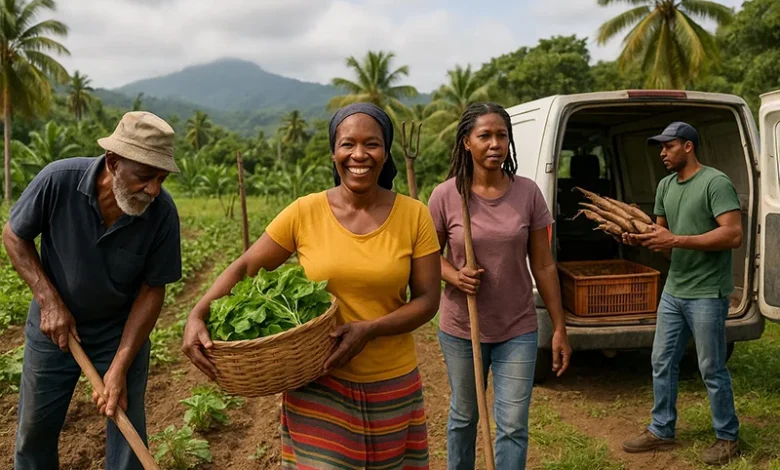Farming in Dominica

Farming in Dominica plays a crucial role in both the country’s economic sustenance and cultural identity. On this lush, volcanic island of 751 km², agriculture remains a cornerstone of life even as the small Caribbean nation transitions toward a more diversified economy. The sector has evolved through dramatic historical shifts, from colonial plantation systems to the banana-driven export economy, and now to a more resilient, smallholder-driven model focused on food security, agro-processing, and niche exports.
Historical Legacy and Modern Diversification
During the 18th and 19th centuries, agriculture in Dominica was dominated by sugar plantations, shaped by British colonialism and enslaved African labour. After emancipation in 1834 and independence from Britain in 1978, the economy pivoted towards banana exports. By the 1980s, bananas accounted for nearly 70% of agricultural exports, with annual production reaching around 30,000 tonnes. This monoculture boom spurred rural employment and infrastructure development, including roads, ports, and packing facilities.
The sector experienced a sharp downturn in the late 1990s due to repeated hurricanes, most notably Hurricane David (1979) and Hurricane Lenny (1999), as well as the loss of preferential EU banana prices. Banana production fell by more than 60% by 1999. In response, the Government encouraged diversification into citrus fruits, coconuts, cocoa, coffee, root crops, spices, and essential oil plants such as bay leaves and seamoss. The citrus industry output surged, with grapefruit yields alone reaching 21,000 tonnes, and oranges contributing about 8,000 tonnes annually by the end of the 1990s.
Today, root crop cultivation has gained traction not only for domestic food needs but also for export. Cocoa and coffee farming, now primarily smallholder-based, nod to agro-tourism trends and slow-food movements. Essential oils, particularly bay oil, have emerged as premium-value products in cosmetic and wellness markets.
Economic and Statistical Overview
Data from 2023 show that agriculture (including fishing and forestry) contributed approximately 4.1% of Dominica’s GDP, while directly employing nearly 26% of the workforce, an estimated 7,000 persons. Roughly 34.7% of the island’s land area is used for agricultural purposes, including both permanent crops and arable lands. While banana export revenues have declined significantly since their peak, smallholder production of root crops and niche export crops continues to maintain a stable contribution of around EC$5–7 million annually to foreign earnings. FAO and regional trade statistics report that, in 2024, Dominica exported over US$610,000 worth of fresh fruit and US$509,000 in condiments and spices, reflecting a shift toward broader crop choices and better smallholder performance.
Farm Support, Extension, and Institutions
Formal agricultural support in Dominica is led by the Ministry of Agriculture, Fisheries, Blue and Green Economy. They coordinate farming extension services, subsidised seed and agro-input distribution, pest and disease management, climate-smart agriculture training, and post-disaster assistance. Since 2008, the Agriculture Investment Unit has focused on diversifying crop production and supporting agro-processing initiatives.
At the grassroots level, farmer cooperatives, such as the Dominica Organic Agriculture Movement and Dominica Essential Oils & Spices Cooperative Society Ltd., provide input buying power, distillation facilities, and access to export markets. A stream of government and donor funding, including technical assistance from the FAO, IICA, CARPHA, World Bank, and IDB, has strengthened rural extension, infrastructure, and value chain development. NGOs like the Caribbean Agri-Trade Support (CATS) also support watershed farming and organic practices in villages such as Soufrière.
Geographic Distribution of Farming
Farming occurs across the Dominican landscape, with several locations standing out for their specialization:
- Calibishie in the northeast focuses on vegetables, bananas, root crops, and fruits, benefitting from its fertile volcanic soils and new collection infrastructure installed around 2012.
- Vieille Case, also in Saint Andrew, supports hillside agriculture of dasheen, peppers, coconuts, plantains, and bananas, tailored to steep terrain.
- Grand Bay and Castle Bruce in the west-central region are centers for citrus, herbal crops, root vegetables, and artisanal oils.
- Urban hubs like Roseau and Portsmouth support processing and export facilitation, packing stations, cold storage, and testing laboratories.
Additionally, smaller community-based farms are spread across parishes like Saint Patrick, Saint Joseph, and Saint David, boosting access to local food security and preserving traditional varieties.
Climate Resilience and Sustainable Practices
Farming in Dominica must continually adapt to climate change and its associated shocks. Hurricane Maria (2017) and Tropical Storm Erika (2015) severely damaged farm infrastructure, resulting in crop losses exceeding 80% in key regions. In response, the government launched various resilience programs, including:
- Grants under the Disaster Vulnerability Reduction Project (DVRP) to rebuild irrigation systems and greenhouses,
- Irrigation kits and water harvesting systems to buffer against drought,
- Agro-forestry training to combine trees and soil conservation in critical watersheds.
These measures, along with agro-chemical reduction initiatives and organic fertiliser training, aim to promote sustainable harvesting, soil health, and natural resource protection.
Agro-Processing and Value Addition
A significant shift is underway from raw crop export toward value-added processing. Local small businesses now produce and export herbal teas, cocoa nibs, coconut-based products, seamoss powders, and bay oil. Processing hubs in Portsmouth and Roseau offer technical assistance in packaging, labelling, and adherence to export standards. Support from institutions such as the Dominica Export Import Agency (DEXIA) and the National Centre of Testing Excellence enables producers to secure international certifications like organic and HACCP compliance.
List of Key Support Institutions:
- Ministry of Agriculture, Fisheries, Blue and Green Economy, extension, subsidies, research
- Farmers’ cooperatives, export agencies, and technical partners (FAO, World Bank, NGOs)
Technological Innovation and Youth Engagement
The integration of modern technology into agriculture has accelerated slowly but steadily in Dominica. While many farmers still rely on traditional methods, there has been a noticeable shift in recent years toward embracing small-scale mechanisation, improved irrigation systems, and the use of organic fertilisers. The introduction of drone technology for land surveying and disease monitoring has been piloted in larger farms, and mobile-based apps are used to provide weather alerts and market information to rural farmers.
Efforts to make agriculture more attractive to younger generations have intensified, particularly through programs supported by the Youth Development Division and regional groups such as the Caribbean Agricultural Youth Network. The government has introduced grant schemes and startup financing for agro-entrepreneurs under the Dominica Youth Business Trust. In the northeast and Kalinago Territory, several youth-led agro-enterprises now produce pepper sauces, herbal extracts, and breadfruit flour for both local and export markets.
The Dominica State College also offers agriculture as a vocational program, preparing students for careers in agri-business, extension, and sustainable farming. In parallel, short courses in greenhouse management, poultry farming, aquaponics, and food preservation have helped bridge skill gaps for young adults entering the sector.
Gender, Community, and Cultural Ties
Women play an integral role in Dominica’s agricultural economy. From cultivating small plots of vegetables to managing community markets, their contributions shape not only household food security but also regional trade. Many women are involved in cooperative distillation of bay oil, cocoa processing, and backyard gardening.
Communities across Dominica often rally around farming as a source of social cohesion and cultural heritage. In Kalinago villages such as Sineku and Bataka, traditional knowledge in growing cassava and arrowroot remains vital. The annual independence celebrations feature a National Exhibition of Local Produce, showcasing innovations and reinforcing cultural pride in farming practices.
Traditional market days, especially in Roseau, Portsmouth, and Marigot, remain central to community life. Farmers bring their produce to town, set up makeshift stalls under tarps, and engage in spirited negotiations. These gatherings provide income, nutrition, and a cultural link between rural producers and urban consumers.
Environmental Conservation and Organic Shifts
With nearly 60% of its land under forest cover and designated as protected areas or national parks, Dominica is uniquely positioned to promote sustainable farming. Agroforestry, the practice of planting crops in conjunction with trees, has gained traction, especially in the Layou Valley, where bananas and citrus now grow under the canopy of breadfruit and coconut palms.
Several farms in Dominica have moved toward organic certification, although the process remains expensive and time-consuming. NGOs such as the GEF Small Grants Programme and the OECS Green Climate Fund Readiness have funded composting, soil testing, and eco-certification workshops to support the transition to organic farming. Roseau Valley, in particular, is known for its eco-conscious farms that cultivate organic herbs, lettuce, and seasoning peppers.
Dominica’s volcanic soil and abundant freshwater features give it a competitive edge in high-quality produce. Combined with low pesticide usage and traditional rotational planting practices, these characteristics offer potential branding opportunities for eco-conscious consumers abroad.
Agricultural Challenges and Outlook
Despite its strengths, Dominica’s agricultural sector faces numerous challenges. Hurricane vulnerability, inadequate access to international markets, rising input costs, and labour shortages remain persistent concerns. Farm labour migration, especially among youth, threatens generational continuity in agriculture.
At the same time, the island’s relatively small land area makes large-scale mechanized farming difficult. The rugged landscape complicates road access to interior farms, especially during the rainy season, and increases transportation costs.
Nevertheless, prospects remain hopeful. The government’s push toward climate-resilient crops, expansion of agro-processing zones, and stronger linkages between agriculture and tourism, such as farm-to-table experiences and rural eco-lodges, signal a modern shift in sectoral thinking. There is also growing interest in carbon sequestration and climate-smart farming practices, which could potentially open up new revenue streams under global carbon trading initiatives.
Major Crops Produced in Dominica (Latest Available Data):
- Bananas: ~7,500 tonnes
- Dasheen (taro): ~3,200 tonnes
- Grapefruit: ~21,000 tonnes
- Citrus (including oranges and limes): ~14,000 tonnes
- Bay leaves: 500–700 tonnes (for essential oil production)
Regional Integration and Export Partnerships
Dominica’s agriculture is closely tied to regional frameworks such as CARICOM’s Regional Food Security Strategy and the OECS Agriculture Plan. Under these frameworks, Dominica has participated in joint procurement of fertilizers, plant quarantine protocols, and regional trade fairs.
Exports to Martinique and Guadeloupe include plantains, sweet potatoes, and seasoning peppers. Shipments to the U.S. have resumed on a trial basis for plantains and mangoes, while bay oil continues to be sent to Europe and North America through trusted buyers.
Bilateral support from friendly nations, particularly through technical training from Cuba and equipment donations from China, has bolstered capacity in greenhouse farming and nursery establishment. Extension officers trained abroad have returned to help local farmers adopt drip irrigation, solar drying systems, and improved propagation techniques.
List of Key Farm Communities:
- Calibishie (vegetables and root crops)
- Grand Bay (citrus, peppers, bay leaves)
- Layou Valley (agroforestry and bananas)
- Castle Bruce (mixed farming and nurseries)
- Kalinago Territory (cassava, sweet potato, herbal crops)
Farming in Dominica remains a symbol of resilience and adaptation. Rooted in centuries of struggle and innovation, it continues to feed families, fuel exports, and offer new paths to prosperity. With sustained investment in youth, technology, and environmental stewardship, agriculture on the island is poised to grow, not in scale alone, but in sustainability, value, and identity.




